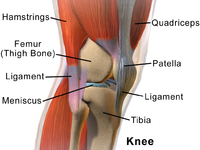
Photo from wikipedia
OBJECTIVES The aim of this study was to assess the reliability, frequency, and clinical significance of temporomandibular joint (TMJ) medial and lateral disk positions, observed in the coronal-oblique plane, to… Click to show full abstract
OBJECTIVES The aim of this study was to assess the reliability, frequency, and clinical significance of temporomandibular joint (TMJ) medial and lateral disk positions, observed in the coronal-oblique plane, to determine their importance in clinical diagnosis and for routine imaging. STUDY DESIGN This cross-sectional study involved secondary data analysis (clinical and imaging) of 401 participants of the TMJ Impact Study. We used the χ2 statistic to evaluate the associations between coronal disk positions with (1) anterior disk displacements with reduction and without reduction; and (2) familiar TMJ pain resulting from excursive movements and palpation, range of motion, and joint sounds. RESULTS Anterior disk displacements of any type occurred in 67.5% of joints; in contrast, medial and lateral disk positions occurred in 16% and 24% of joints, respectively. Radiologist reliability was as follows: sagittal posterior band position: right κ = 0.68, left κ = 0.60, average 84% agreement; and medial or lateral disk position: right κ = 0.36, left κ = 0.32, average 70% agreement. Medial and lateral disk positions were associated with sagittal displacements (P < .001). However, there were no associations between medial and lateral disk positions and familiar pain, range of motion, and joint sounds. CONCLUSIONS Coronal disk position does not contribute to clinical symptomatology or findings and currently lacks sufficient evidence to support its inclusion into standard TMJ imaging protocols or into a clinical diagnostic category.
Journal Title: Oral surgery, oral medicine, oral pathology and oral radiology
Year Published: 2020
Link to full text (if available)
Share on Social Media: Sign Up to like & get
recommendations!